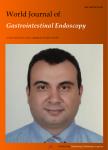Role of preoperative tracheobronchoscopy in newborns with esophageal atresia:A review
Role of preoperative tracheobronchoscopy in newborns with esophageal atresia:A review作者机构:Department of Pediatric Surgery Azienda Ospedaliera Spedali Civili 25123 Brescia Italy Department of Pediatric Othorinolaryngology Azienda Ospedaliera Spedali Civili 25123 Brescia Italy Department of Pediatric Anesthesiology and Intensive Care Unit Azienda Ospedaliera Spedali Civili 25123 Brescia Italy University of Brescia 25123 Brescia Italy
出 版 物:《World Journal of Gastrointestinal Endoscopy》 (世界胃肠内镜杂志(英文版)(电子版))
年 卷 期:2014年第6卷第10期
页 面:482-487页
学科分类:1002[医学-临床医学] 100202[医学-儿科学] 10[医学]
主 题:Computed tomography scan Esophageal atresia Newborns Tracheobronchoscopy Tracheo-esophageal fistula Tracheomalacia
摘 要:Preoperative tracheobronchoscopy(TBS) in the diag-nostic assessment of newborns affected by esophageal atresia(EA) was described in 1981. Nevertheless, the value of the procedure is actually much debated; only a few studies have clearly explored the advantages of TBS and this procedure is not yet routinely included inthe diagnostic and therapeutic assessment in many in-ternational pediatric surgery settings. Routine preoper-ative TBS is a safe procedure that enables the accurate examination of the tracheobronchial tree, the visualiza-tion of tracheoesophageal fistula and the diagnosis of tracheomalacia or associated respiratory anomalies. When a distal fistula is found, its occlusion with a Fog-arty balloon catheter improves mechanical ventilation and facilitates surgical repair. This review provides a detailed overview on the use of TBS in newborns with EA, focusing on technical aspects, anesthesiological management, indications and limits. The benefits and risks of the procedure are also compared with alterna-tive diagnostic tools, such as an esophageal contrast study, computed tomography scan and ultrasound.



